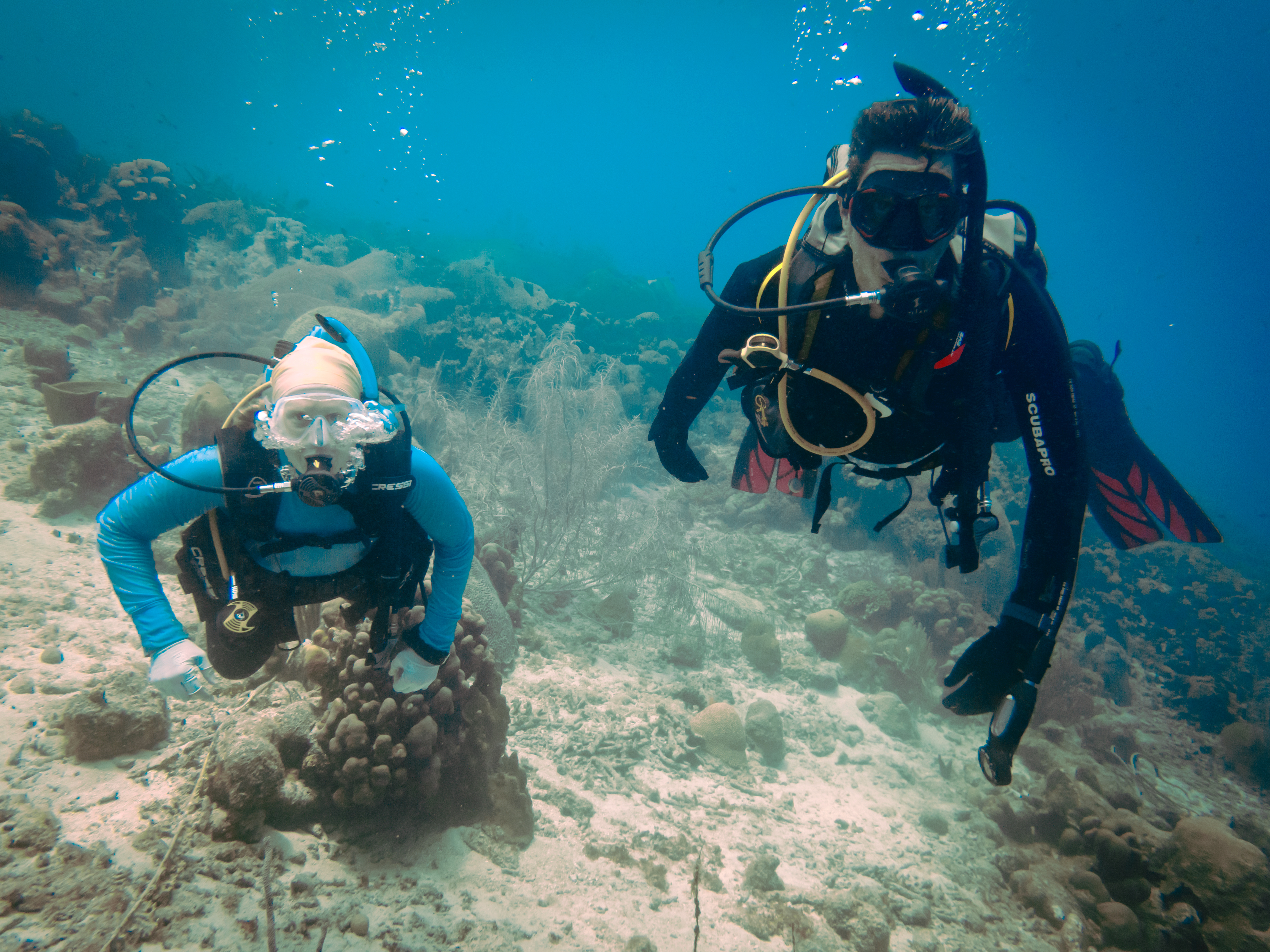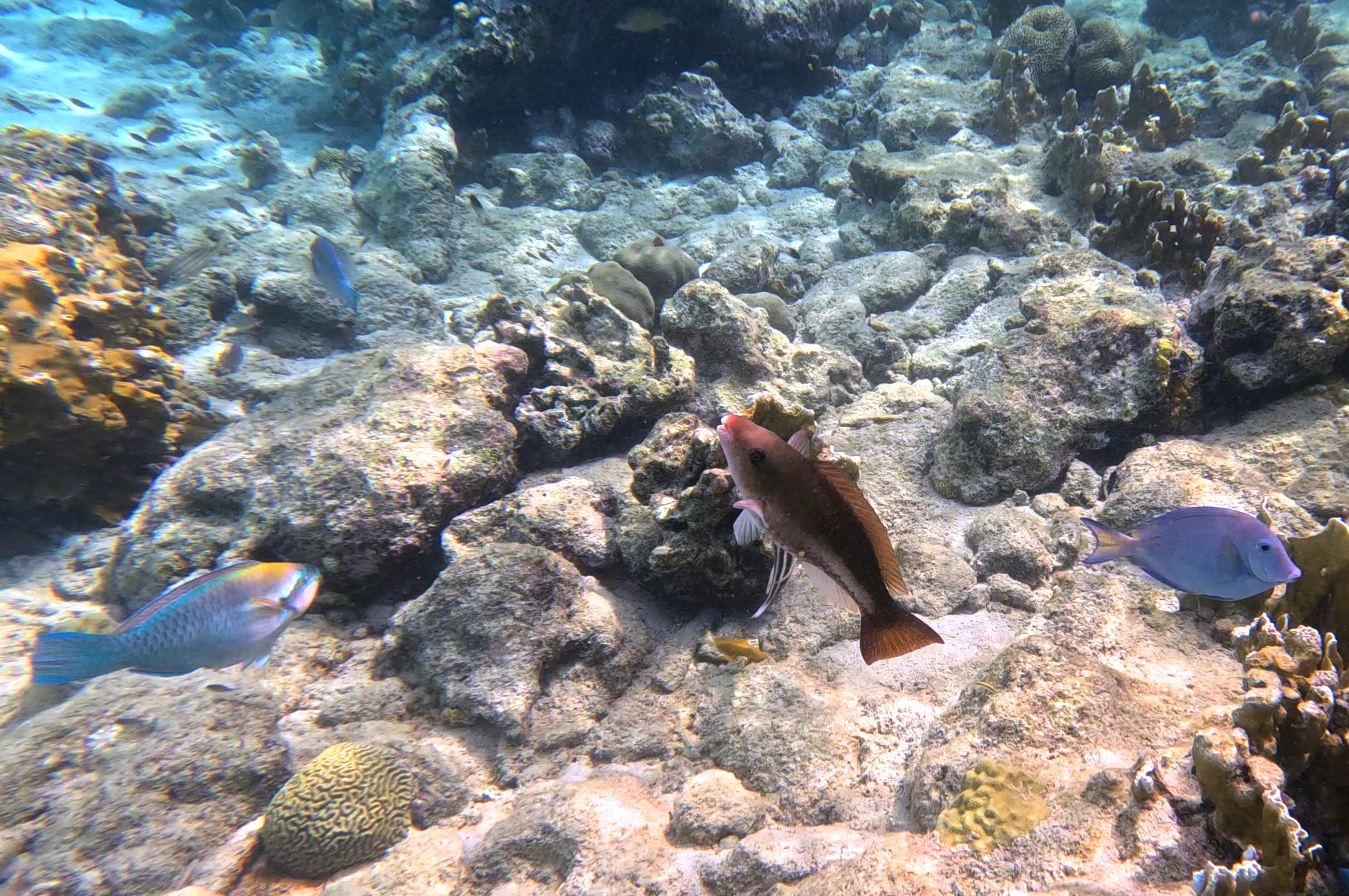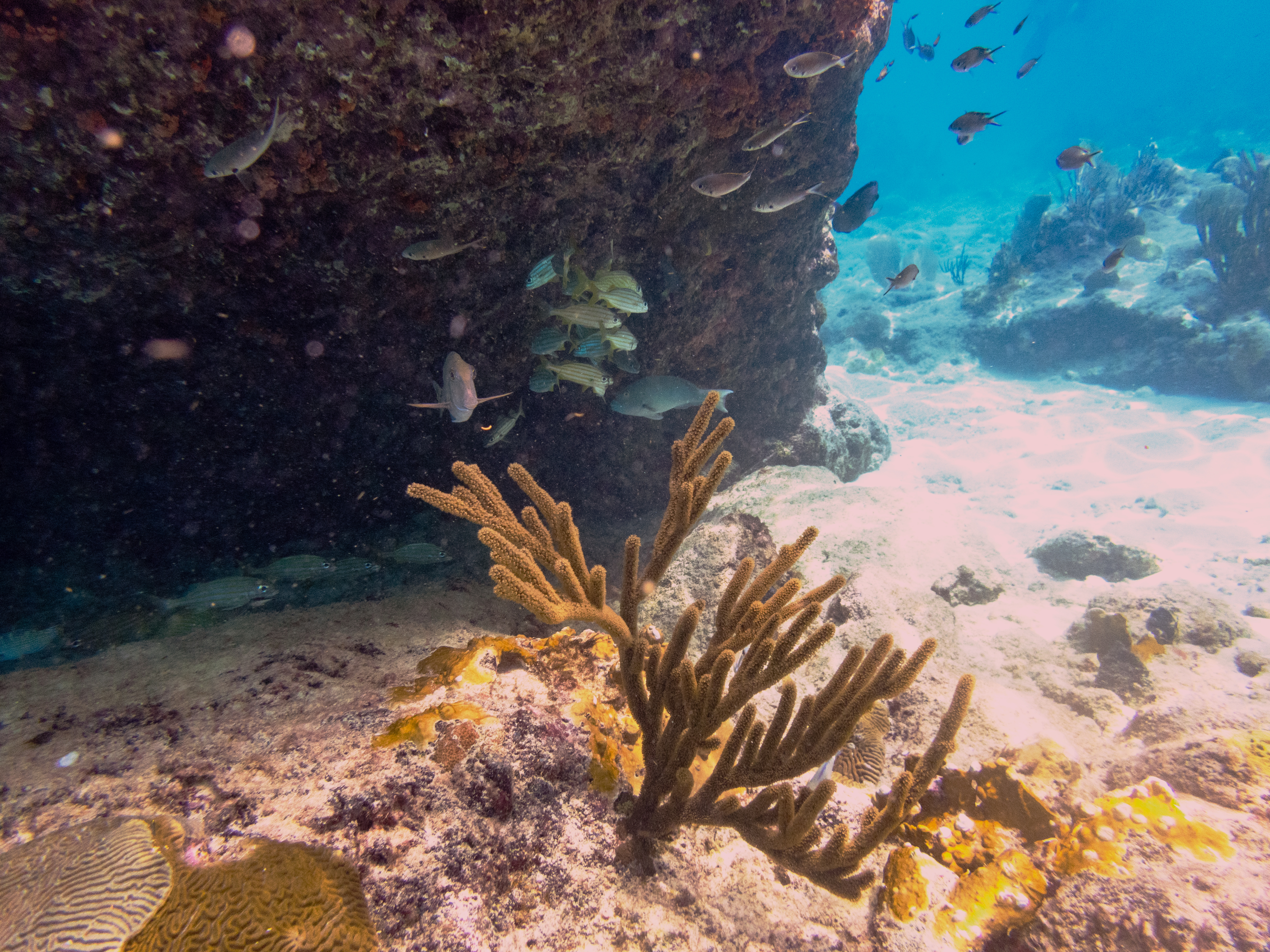UNM researchers take a deep dive into our changing planet with SIMReef project
July 31, 2023 - by Kim Delker

UNM's Julie Hayes and Matthew Fricke during field research in Curaçao. (Photos by John Ericksen)
As we all endure a record-hot summer that scientists say is largely the result of climate change, the tangible evidence is all around us, including triple-digit temperatures, wildfires, drought and floods.
And while the impacts of a changing climate are evident and trackable above ground, a lesser-known area of study involves the impact it is having where we can’t see — in the ocean. That is the focus of research being conducted by University of New Mexico researchers in the Department of Computer Science who recently undertook fieldwork in Curaçao to model some out-of-the-ordinary data points they could not access in land-locked New Mexico: coral reefs.
Melanie Moses, professor of computer science, is a co-principal investigator of a National Science Foundation project called “Emergence of function and dynamics from ecological interaction networks” being led by ecology and evolutionary biology assistant professor Mike Gil from the University of Colorado, Boulder. The $3 million project, which is a collaboration between multiple universities, is funded through Sept. 30, 2027.
The team’s goal? To create a software model called SIMReef that represents millions of fish foraging for algae on coral reefs. They are seeking to understand how fish, coral and algae interact in a changing ocean to predict how coral can best be protected in increasingly inhospitable conditions.
Moses, along with the UNM team of Matthew Fricke, a research assistant professor in computer science, and Julie Hayes, a Ph.D. student in computer science, traveled in May to the CARMABI marine biology research station, Curaçao. In the clear, blue waters there, they had the opportunity to dive in the ocean, exploring coral reefs and the impacts that climate change has had on ocean life, documenting the relationships between coral, algae, and the fish that live there with photos and video.
The world’s coral reefs are some of the most biologically rich ecologies on the planet, which cover only 1% of the ocean floor, but contain a quarter of all ocean life. The U.S. National Oceanographic and Atmospheric Administration estimates the economic benefit of coral reefs to the United States alone at $5.2 billion a year. But unfortunately, coral reefs and the animals that they house are being destroyed. From 2014 to 2017, 75% of coral reefs were impacted by global warming.
“The main threats to coral reefs are increasing temperatures and fertilizer runoff,” Fricke said.
Moses said that when temperatures rise, corals expel the photosynthetic micro-organisms that produce their food, causing coral bleaching and eventually death.
"We are seeing coral die in real time in the extreme water temperatures off the coast of Florida this summer, reaching over 100 degrees Fahrenheit," Moses said. "However, some healthy coral ecosystems remain, and our goal is to understand what helps them to survive."

Fish grazers can help keep algae growth in check, but the fish are also being impacted by the overall ocean health, including diminishing habitat from coral reefs, and this makes algae overgrowth more likely.
However, a possible solution to this issue is found in a most unusual collaboration of research specialties. Marine biologists led by CU Boulder are teaming up with UNM computer scientists to translate what they have observed in Curaçao to develop a computer model of coral, algae, and fish interactions to better understand how fish populations control algae and keep reefs healthy.
The team spent many hours observing coral, algae, and documenting algae-eating parrotfish and surgeon fish to better understand their behavior and their impact on the reef. They gained some great images and unique experiences, but also valuable data. After fieldwork each day, they helped students at the CARMABI marine biology research station perform statistical analysis of the behaviors captured on video during the day. This data, along with recordings from mounted underwater cameras, will be used to build the coral reef model SIMReef.
SIMReef’s purpose is to simulate how coral reefs will respond under different fish behaviors and algae overgrowth scenarios. By predicting what could happen, the impact of human-caused environmental changes that are harming the ocean ecosystem could be better understood, ideally leading to specific interventions that can slow the destruction of coral reefs.
“Coral reefs are so important and support so much life, but they are dying, and we are trying to understand exactly what is going on and what can be done about it,” Fricke said.

Throughout the fieldwork, he said he was literally immersed in his work, choosing a fish to follow for a hours at a time to see how much time it spent consuming algae, fleeing from predators, and interacting with other fish. Fricke, who had never scuba-dived before this project, is now a certified scuba diver.
“We believe that in order to write effective programs to model any process in nature, whether that is volcanos, ants, the immune system or coral reefs, it is essential to observe the physical system directly,” he said.
SIMReef was inspired by Moses’ previous research in 2020, also funded by NSF, that looked at how human lungs respond to viral pathogens like COVID-19. In that research, Moses developed a tool called Spatial Immunological Model of Corona Virus (SIMCoV) that uses computer simulations and laboratory data to visualize interactions between immune cells and the virus within the lungs. SIMCoV examines variability in viral load, which correlates with how infectious the patient is across infected individuals and through time.
In the same way, SIMReef will produce simulations based on activity in the ocean that impacts coral reefs and other ocean life.
“SIMCoV was such a great idea, and the team realized that the interactions of fish and algae on coral reefs share a lot of similarities with the interactions among immune cells and viruses in lung tissues,” Fricke said.
Moses said the previous project provided a strong foundation for the current project, as well as the partnership of UNM’s Center for High Performance Computing (CARC), where Fricke is an affiliated faculty member.
“Because we had years of experience running SIMCoV at CARC, we realized we could simulate fish foraging at a large scale that was not possible with previous models,” Moses said.
Both Moses and Fricke consider themselves “field computer scientists” — not ones that just sit in a computer lab.
Moses, whose background is in biology, has long been interested in the intersection of biological processes and computer science through computational biology and biologically-inspired computation. She developed NASA Swarmathon, which is a swarm robotics challenge in which students from minority-serving institutions develop algorithms for robotics used for space exploration. And Fricke has been involved with other field research, such as UNM’s Project VolCAN, traveling to Spain’s Canary Islands in 2021 and made history by becoming what is believed to be one of the first research teams to collect uncontaminated gases from an active volcanic eruption (via drones). He is also involved in extensive fieldwork to monitor CO2 in Iceland post-volcano as well as a CO2 survey of a volcanic field in Utah.
He said that projects like SIMReef and VolCAN are great showcases for the field of computer science — its breadth and depth as well as its relevance to other disciplines through collaborations.
“One of the nice things about computer science is that it can be used for all kinds of things,” Fricke said. “Projects like these are one of the reasons I became a computer scientist. Plus, it’s a nice change to get out of the office once in a while.”
